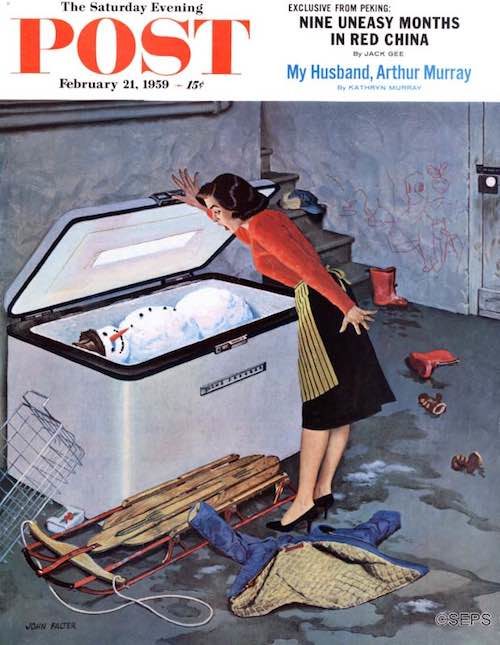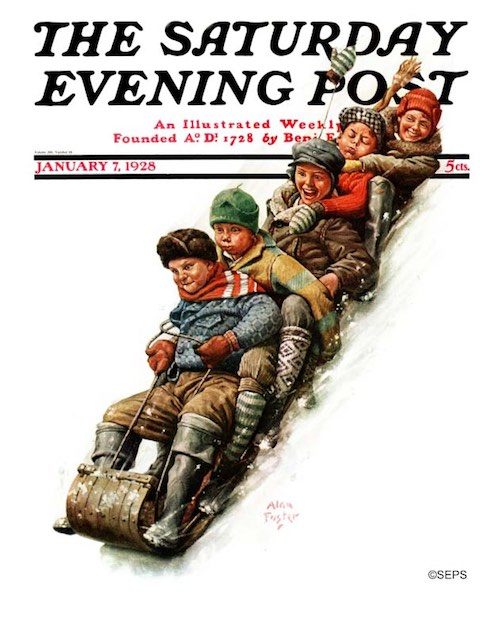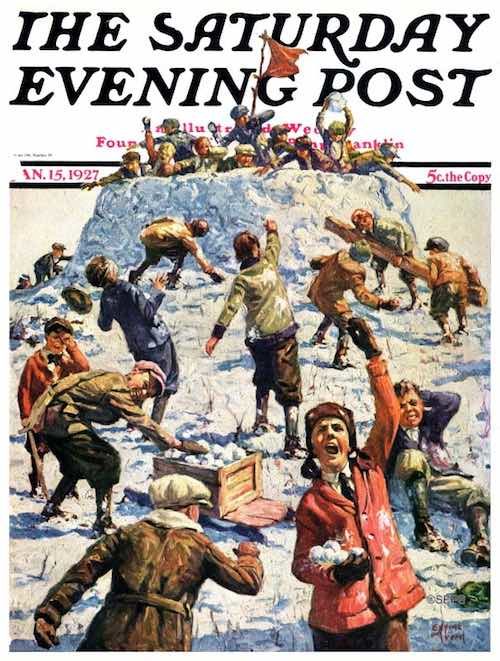The days are short, but that doesn’t mean a shortage of fun! The mischievous kids featured on our vintage covers know how to make the most out of a fresh snowfall.

Earl Mayan
January 28, 1961
A blizzard zeroed in on Icicle Avenue last night, and this morning—gangway!—the sleds are taking over. This is the sort of weather that makes a person appreciate the sled’s advantages over the automobile. For instance, a sled doesn’t need antifreeze or windshield scrapers. There are no speed or age limits for sledding. Sleds are easy to start, even on the coldest mornings. (Especially on the coldest mornings.) You can drive a sled no-handed, and if you run into a snowdrift, why, what could be more fun?

John Falter
February 21, 1959
For a split second mother thought she saw a real man lying there, stark and grinning. Readjusting her senses (mothers get to be fast readjusters), she thought, Oh, come now, one doesn’t fin d real men in freezers, does one? This is a snowman, I fear. Next thing on the agenda is to remove Mr. Smiley from his mausoleum. As mother icily summons her son and they messily lug sections of Smiley out the basement door, mother can reflect upon how funny this will seem to her week after next. Alternate plan: artist John Falter says there is a pile of displaced freezer food off stage at the left; why not lug that outdoors to keep cool and save funny Mr. S. for papa to enjoy, and remove, when he comes home? In that case, papa could reflect that a father’s work is never done

John Falter
January 24, 1959
This hard working man’s tactical problem is whether to cross the street in a flanking movement, or charge the foe and take what is coming to him, which is plenty. What would artist John Falter himself do? He says, “This scene (except for that ornamental ball, which I contributed) is a pleasant, typical Midwestern town I recently visited, named Bad Axe, Michigan.” He says, “I would charge the foe. I think.”

John Falter
December 18, 1948
John Falter’s sledding hill is an imaginary one he designed as a boy, long before he had any idea of becoming an artist. Where he grew up in Nebraska, the countryside was fairly flat. When Falter was the age of some of the boys in his picture, he used to imagine a hill like this one—steep enough, long enough (although you can’t see that part) and with a sporting curve near the start of the runway. He got around to painting the scene last fall while visiting Atchison, Kansas, when the temperature was ninety. The blue-and-tan sled belongs to a boyhood friend—and the friend’s son. Falter recalled it from his own childhood; it was still in good shape.

Alan Foster
January 7, 1928
Why sled alone when you can quintupple the fun? Many of Alan Foster’s 30 covers for the Post were joyful and Rockwellian in nature: kids playing sports, going on a hayride, or getting in trouble in school…or making the most of a snowy day. About three-fifths of these kids seem to be having a blast; the others aren’t so sure.

Eugene Iverd
January 15, 1927
Based on this tumultuous snowy scene, it’s unsurprising to find out that this artist grew up in Minnesota. George Erickson, who painted under the “brush name” Eugene Iverd, was one of the best-known illustrators in the 1920s, painting for Campbell’s Soup and The Saturday Evening Post. This particular painting reminds us of Lord of the Flies, even though Golding’s book wasn’t published until 1954, 27 years later. (Maybe Iverd’s painting inspired him.)

Sarah Stilwell Weber
March 3, 1917
Artist Sarah Stilwell Weber was particularly adept at creating movement and flow that gave the impression of coming and going. You had the distinct impression that the subject would dance off the page in the next moment (or nail you with a snowball). She was one of the first female cover artists for The Saturday Evening Post, completing her first cover in 1904.
Become a Saturday Evening Post member and enjoy unlimited access. Subscribe now




Comments
Love the top cover. Fun for the kiddies; the adults not so much. ‘Frosty in the Freezer’ is wonderful. This lady is the most shocked (I think) since the red dress hostess in ‘Doggy Buffet’ two years earlier.
A ‘Snowy Abush’ is the last thing this man needs! The next two covers look like a lot of fun. Eugene Iverd’s cover is very well done. The ‘Lord of the Flies’ aspect would have me steering clear of their fort.
The 1917 cover by Sarah Stilwell Weber is wonderful. Some of the best POST covers were by female artists. I love the young woman’s facial expression because it’s tough to determine whether she’s about to throw that snowball at someone or not. She’s smiling, so maybe she’ll throw it and “miss” on purpose.